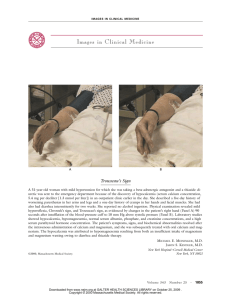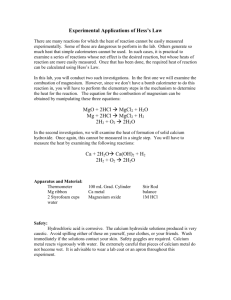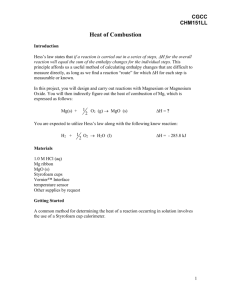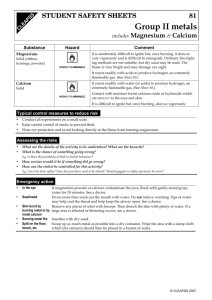Thermochemistry Lab #3
advertisement
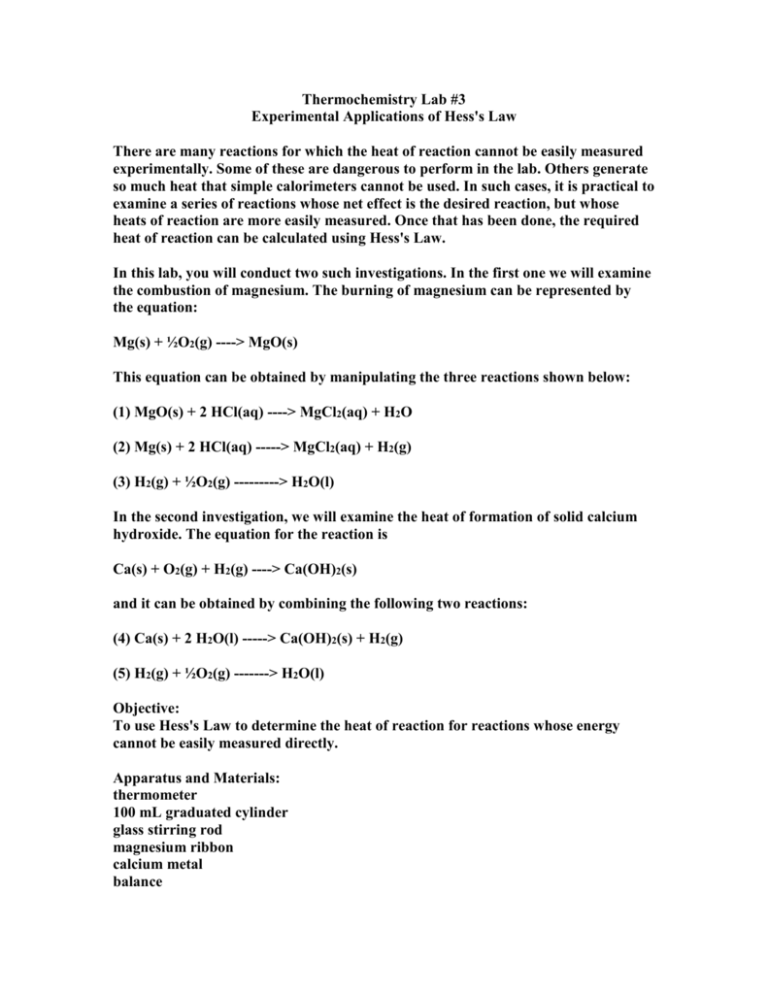
Thermochemistry Lab #3 Experimental Applications of Hess's Law There are many reactions for which the heat of reaction cannot be easily measured experimentally. Some of these are dangerous to perform in the lab. Others generate so much heat that simple calorimeters cannot be used. In such cases, it is practical to examine a series of reactions whose net effect is the desired reaction, but whose heats of reaction are more easily measured. Once that has been done, the required heat of reaction can be calculated using Hess's Law. In this lab, you will conduct two such investigations. In the first one we will examine the combustion of magnesium. The burning of magnesium can be represented by the equation: Mg(s) + ½O2(g) ----> MgO(s) This equation can be obtained by manipulating the three reactions shown below: (1) MgO(s) + 2 HCl(aq) ----> MgCl2(aq) + H2O (2) Mg(s) + 2 HCl(aq) -----> MgCl2(aq) + H2(g) (3) H2(g) + ½O2(g) ---------> H2O(l) In the second investigation, we will examine the heat of formation of solid calcium hydroxide. The equation for the reaction is Ca(s) + O2(g) + H2(g) ----> Ca(OH)2(s) and it can be obtained by combining the following two reactions: (4) Ca(s) + 2 H2O(l) -----> Ca(OH)2(s) + H2(g) (5) H2(g) + ½O2(g) -------> H2O(l) Objective: To use Hess's Law to determine the heat of reaction for reactions whose energy cannot be easily measured directly. Apparatus and Materials: thermometer 100 mL graduated cylinder glass stirring rod magnesium ribbon calcium metal balance 2 - 250 mL large styrofoam cups styrofoam cup lids solid magnesium oxide 1.0 M HCl solution distilled water Safety: Hydrochloric acid is corrosive. The calcium hydroxide solution produced is very caustic. Avoid spilling it on yourself. Wash immediately if it contacts your skin and inform your teacher. Safety goggles are required when handling caustic or corrosive materials. Calcium metal reacts vigorously with water. Be extremely careful that pieces of calcium metal on the desk do not become wet. It is advisable to wear a lab coat or apron throughout the experiment. Procedure: Part One: The Combustion of Magnesium 1. Read through the procedure carefully and review the data table prepared at the end of this lab. 2. Put 100 mL of 1.0 M Hydrochloric acid solution into the styrofoam cup. Record the temperature of the solution. 3. Accurately find and record the mass of about 1 g of solid magnesium oxide. 4. Add the solid magnesium oxide to the acid solution in the cup. Stir the mixture and record the highest temperature possible. 5. Discard the solution and rinse the cup thoroughly with water. 6. Put 100 mL of 1.0 M HCl solution into the styrofoam cup. Record the temperature of the solution. 7. Accurately find and record the mass of about 1.0 grams of magnesium ribbon. 8. Add the magnesium ribbon to the acid solution. Stir the mixture and record the highest temperature reached. Part Two: The Heat of Formation of Solid Calcium Hydroxide 9. Punch two holes in the lid of the styrofoam cup, one for the thermometer, the second to allow for the addition of the calcium and the release of the hydrogen produced. 10. Put 100 mL of distilled water into the styrofoam cup. 11. Put the lid on the cup and insert the thermometer through the hole you created. Record the temperature of the water. 12. Record the mass of about 1.0 g of calcium metal. CAUTION: Do not allow any of the calcium metal pieces to become wet. 13. Add the calcium to the water through the pre-punched hole. 14. Stir the mixture and record the highest temperature reached. Calculations Part One 1. From your data, calculate the following for each part of the experiment. a) The temperature change of the solution. b) The heat absorbed by the solution. (assume c=4.184 J/goC) c) The number of moles of (1) magnesium oxide and (2) magnesium used. d) The heat of reaction in kJmol-1 of (1) magnesium oxide and (2) magnesium reacting with the hydrochloric acid. 2. Show how equations (1),(2) and (3) in the introduction can be combined to give the equation for the combustion of magnesium. 3. Use your experimental values for the two reactions in the experiment, along with a value for the heat of reaction for equation (3) found in a chemistry handbook to calculate the heat of combustion for magnesium. 4. Compare your calculated value with that found in tables for the standard heat of formation of magnesium oxide. Find the experimental error. Part Two 5. Show clearly how equations (4) and (5) in the introduction can be combined to produce the equation for the formation of solid calcium hydroxide. 6. Use your experimental results to calculate the molar heat of reaction for the reaction of calcium with water in kJmole-1 of calcium used. Using this value, and the value of the heat of reaction for the equation H2 + ½O2 ----> H2O(l) calculate the molar heat of formation of calcium hydroxide. 7. Compare your calculated value with that listed in a chemistry handbook and calculate your experimental error. Questions In this experiment, it was assumed that the calcium hydroxide formed was in the solid form, whereas some of the solid which formed must have dissolved. Using a chemistry handbook, find out how soluble calcium hydroxide actually is. Using this information, determine how much of an impact the above assumption had on the final experimental value for the heat of formation of calcium hydroxide. Experimental Applications of Hess's Law Data Table Part 1 (a) Volume of 1.0 M HCl solution used = mL Mass of magnesium oxide used = g Initial temperature of 1.0 M HCl solution before mixing = oC Final temperature of solution after MgO added = Calculations delta T = oC oC Energy produced, E = kJ Moles of MgO used = mole Hrxn = kJ/mole Balanced Reaction: Part 1 (b) Volume of 1.0 M HCl solution used = mL Mass of magnesium ribbon used = g Initial temperature of 1.0 M HCl solution before mixing = Final temperature of solution after Mg added = oC oC Calculations delta T = oC Energy produced, E = Moles of Mg used = Hrxn = kJ mole kJ/mole Balanced Reaction: Part 1 Discussion Apply Hess's Law of equation additivity to Part 1 (a) and Part 1 (b)'s equations. Don't forget to look up the third needed equation from the databook. Part 2 Volume of H2O used = Mass of calcium used = mL g oC Initial temperature of H2O before mixing = oC Final temperature of Ca(OH)2 solution = Calculations delta T = Energy produced, E = Moles of Ca used = Hrxn = oC kJ mole kJ/mole Balanced Reaction: Apply Hess's Law to the above reaction and remember to add in the water equation from your Data Table. Compare your Hrxn with the equation from your data handbook: accepted databook value: kJ/mole % experimental error = % Error Analysis: My experimental value is different from the accepted value because......


